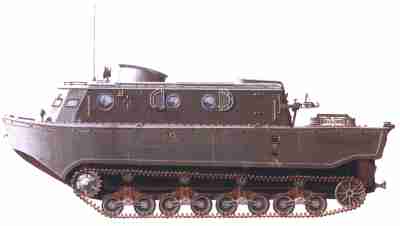He was a Captain and Deputy Chief of the 1122nd Rifle Regiment,334th army,a and stock 4th Shock army. Even thoe he was known for kills he also took out a tank and 3 tractors by himself. (Not sure what the tractors mean?)
Tractors I believe were vehicles that towed stuff,for example tank recovery vehicles,artillery tractors,and this amphibious cargo hauler.
Land-Wasser-Schlepper

In 1936, Rheinmetall Borsig AG was approached by the German army general staff to build a special amphibious tracked vehicle for landing operations. The tractor would be able to two behind it a floating trailer capable of accommodating vehicles or other cargo weighing up to 18,000kg. On water the tractor would function as a tug for the floating cargo trailer. After landing the tractor would still have to move the trailer to a safe place to unload the cargo.
Rheinmetall tackled the project and the product became known as the Land-Wasser-Schlepper (land-water tractor) or LWS. The LWS was actually and simply a motor tug built with tracks. It was a large and strange machine that nonetheless turned out to be a rugged vehicle (or boat?). There were two long sets of tracks, one on the flat bottom on each side of the LWS. There were four pairs of road wheels suspended from leaf-spring suspensions on each side. The boat part of the LWS had a clean, pronounced bow, and on top there was a compartment for the crew of three and extra room for another 20. The funnel-like structure on top of the cabin was actually the engine’s air intake. Two large propellers were installed at the rear, or stern, for propulsion in water. To make the LWS more boat-like there were portholes on both sides of the crew cabin.
On land the floating trailer looked like a large slab-sided vehicle, and was supported by wheels on one forward axle and two rear ones. On the back side a ramp could be opened for unloading. A typical load was an SdKfz 9 18-tonne halftrack, and the crew would be housed in the LWS for the aqueous leg of the journey.
The LWS and trailer idea was tried and tested quite slowly and leisurely until “Seelöwe” (Operation Sea Lion, the invasion of Great Britain) was to become reality after the fall of France. The LWS and trailer could certainly be used in such an amphibious operation, but they were more suited for calmer waters of inland water bodies, not the tempestuous English Channel. The LWS program was for a while carried out with more urgency, but was never materialized. By 1941 the project was dropped, when the prospect of Seelöwe was overshadowed by the much more serious Operation Barbarossa (invasion of Russia).
One disadvantage of the LWS was the lack of armour, and armour was deemed necessary for any amphibious operations. The floating trailer was also thought to be too cumbersome and clumsy so a new scheme was devised. The overall structure of the LWS was kept, but the new vehicle had the track work and suspension of the ubiquitous PzKpfw IV to support a lightly armoured superstructure.
Two new vehicles, called Panzerfähre or PzF, were built and designed to take a large pontoon between them to transport a tank or other cargo. Thus the PzF would act as a ferry rather than a tractor. However, the program was cancelled in 1942 after the two prototypes were built and tried. A pre-production of seven LWS’s were built and they served on the Eastern front. After the war the LWS was taken by the British to England for technical assessment.
http://www.diggerhistory.info/pages-armour/amphib/german.htm
Also there was artillery tractors

Artillery tractor
From Wikipedia, the free encyclopedia
Jump to: navigation, search
Komsomolets tractor
Komsomolets tractor
Artillery tractor is a kind of tractor, also referred to as a gun tractor, a vehicle used to tow artillery pieces of varying weights. The first such devices were designed prior to the outbreak of World War I.
There are two main types of artillery tractors, depending on the type of traction. Wheeled tractors are usually variations of lorries adapted for military service. Tracked tractors run on caterpillar track, and in some cases are built on a modified tank chassis with the superstructure replaced with a compartment for the gun crew or ammunition. The idea of half-track tractors was mostly discontinued after the World War II. In modern warfare, engineer vehicles of a different primary purpose sometimes double as artillery tractors in order to reposition guns. An example of this is the U.S. Marines’ Light Capacity Rough Terrain Forklift (LCRTF), a versatile telehandler forklift which is capable of towing gear from either end.
Armoured recovery vehicle

Conqueror Armoured Recovery Vehicle 2
An armoured recovery vehicle (ARV) is a type of armoured fighting vehicle used to repair battle or mine damaged as well as broken-down armoured vehicles during combat, or to tow them out of the danger zone for more extensive repairs.
ARVs are normally built on the chassis of a main battle tank (MBT), but some are also constructed on the basis of other armoured fighting vehicles, mostly armoured personnel carriers (APCs). ARVs are usually built on the basis of a vehicle in the same class as they are supposed to recover—thus, a tank-based ARV is used to recover tanks, while an APC-based one recovers APCs, but does not have the power to tow a much heavier tank.
http://en.wikipedia.org/wiki/Armoured_recovery_vehicle





